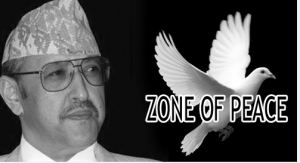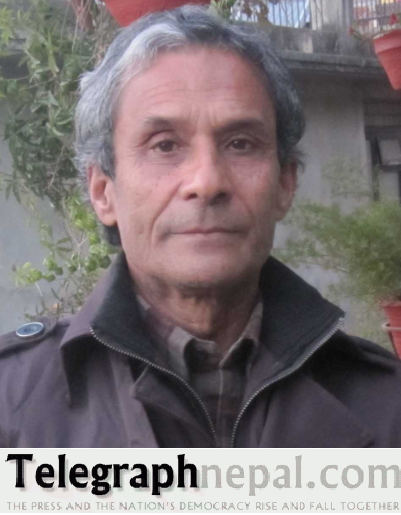Professor Anand Aditya, Kathmandu, Nepal
“Nothing is so powerful as an idea whose time has come,” said Victor Hugo.
Wading through the strands of arguments that Isabelle Duquesne weaves into her thesis, the evidence she gathers, and the scope for Nepal as a zone of peace (NZOP) that she profiles indeed leaves the reader with the feeling that peace is the idea whose time has come.

But, has it really? And if it has, can one hope for that idea to stage a comeback? In the fifteen years between 1975 and 1990, 116 countries supported that proposal, but like its predecessor, the declaration on the Indian Ocean as a zone of peace resolution of the 26th session of the UN General Assembly- it hangs in limbo.
That failure can be attributed mainly to the startling absence of citizens in the debate but also to the inability of other stakeholders in peace in and around the region who could not take up the cause with integrity and energy because Delhi pooh-poohed it and Moscow followed.
As Abraham Lincoln observed, nothing in the world is solved conclusively, unless it is solved correctly, and the author sets out to address the historic amnesia in this volume to clear the many cobwebs that have gathered around the idea, an idea which now lingers in the people’s memory as little more than a footnote of history.
The death of their kith and kin, and the debris of destruction left behind by a whole decade of unprecedented violence have left the people in Nepal pining for peace as never before and the wish for peace is there.
But, is there the will for it?
At a time when the political parties are spending more time arguing for power and privilege than on a national roadmap, can they be expected to muster enough support to make it the people’s agenda?
And, after thirty-six years of hibernation, can the idea rise as the Phoenix did from the ashes of its past failure?
The author believes it can, forwarding her proposition with a certain thrust and often stirring the reader’s imagination to a height wherefrom it is hard to descend, yet, keeping it firmly grounded on reality.
Comprehending peace is not easy and putting it into practice is even less so. The weasel-like nature of peace has been defined diversely and deviously. “A just peace,” said Bill Mauldin, “is one when one side gets what one wants,” and peace in international relations often becomes a period of cheating between two periods of fighting, as Ambrose Pierce put it, rather than a co-existential pursuit, as Bertrand Russell advised.
Such difficulties notwithstanding, the movement for peace is making a noticeable headway. It is now a key staple of contemporary political literature and pacifism a major presence in the global scene.
The forces of peace are certainly not alone.
Thomas C. Wiegele’s Biopolitics, to illustrate, is a search for a more humane political science offering a fresh outlook on the peace discourse, and Young Sek Chou’s Oughtopia explores the scope for an ideal society based on trust, cooperation, and service.
Apart from such theoretical efforts to lay a firm conceptual foundation for irenology-the science of peace-the trends emerging in contemporary world history add hope further.
After a tortuous and torturous struggle, the Irish issue stands closer to solution.
France and Germany have left their centuries of war behind to become friends.
Turkey, which fought wars with almost every neighbor in the past, finds its ‘peace at home, peace abroad’ policy bringing rich dividends.
After years of investing in nuclear weapons South Africa has decided to denuclearize itself.
And, since the proclamation of the Unden Plan in 1961, various nations and regions have declared their own nuclear free zones.
The symbolic peace capability of communities, too, is gaining strength in its own way.
The International Day of Peace, 21st and October 2 (Gandhi’s birthday announced by the UN as a universal day of peace) offer opportunities for communities, groups, and organizations worldwide to come together and express their support for peace.
A global community is also emerging, armed with human rights and assisted by a new generation of peacekeeping efforts — Multi Dimensional Peace Support Operations (PSOs) as also organizations such as the Global Partnership for the Prevention of Armed Conflict (GPPAC).
Closer to home, the social charter adopted at the 11th SAARC Summit in 2002 in Kathmandu made a good beginning as did the people- to-people non-formal dialogue to reinforce global peace movement in establishing peace in a region that boasts a superlative position in poverty and the military force ratio.
That the world’s Buddhist community and UNESCO have bestowed the status of World Polity on Lumbini, the birthplace of Buddha, the enlightened, is another piece of good news in the string of events.
To say peace zone in such a context, is to pursue positive neutrality, a choice that is easier said than done.
It would be easier to obey, and easier to bend and bow.
But, if the peace agenda is to become more than just a vanity project, the agenda has to be pursued with all the seriousness it demands and the efforts we can muster, since it is the only option left for us, whether to safeguard the vital interests of this land or to ensure the twin processes of democratization and development.
The author’s discourse does not make it the conventional kind of treatise on politics of which the market has plenty.
It, instead, tries to explain the ethos that suffuses the nation’s drive for peace and charts out the route to make it possible, building it up not just as a national agenda, but as a multilateral regional mission buyable by the neighbors as well.
This is where her proposal stands sharply apart from its previous version. In the course of revisiting the idea, the author reshapes it as a potent legislative initiative, as a national characteristic of the Nepali folk- soul, which she believes to be its very Dharma where violence, by and large, is an imported cultural phenomenon, and which can ensure stability and security in the region and around.
But, given that the second most water-rich country in the world cannot even quench its thirst, given that most of the past century makes it a century of lost decades, and given, moreover, that the Westphalian paradigm of state security fixated on machtpolitik and secret covenants still guides regime behavior around the region, how much sense would all this make?
Fitting the current geopolitical context in line with the circumstances of the 2l st century, the author advances her premise on border security as a commitment to a joint framework and joint operation as the Swiss, the Germans, and the Austrians have, to secure their common borders on Lake Constance. (Doesn’t that ring the bell on the way we mishandled Kalapani?)
NZOP could become a stabilizing influence to help technocrats evaluate the degree of globalization that is beneficial to Nepal, which she-the author of the book, says, induces a certain conditionality on governance in the use of and gradual weaning from aid, implying power shifts from governments to the country’s citizens.
Situating her proposition in a multi-layered framework — from the local to the global — she draws profusely from a whole repertoire of ideas and tools such as the Global Compact, Athens Ethical Principles, Global Reporting Initiative, the Nuclear Weapons free zones (NWFZ) of cities, countries, and whole regions, as also the impressive record of La Coordinadora of El Salvador.
All this makes ample sense. She also does not forget to boost up her arguments with the help of concepts like The Triple Bottom Line (TBL), Materiality, Conflict-Sensitive Business Practice (CSBP), Conflict Analysis Framework (CAF), Servant Leadership, and Voluntary Simplicity.
Voluntary Simplicity is a principle applied through federal and national plans for access to resource and distribution of wealth, which the author feels must be incorporated into the constitution for publicly elected representatives and appointees with clear limits on the use of rights, powers, and authority on the use of resources.
Such declaration could take the form of a UN territorial peace declaration as a Nepali version of cantons at peace with themselves and with each other, pooling together the core competencies of the SAARC’s member states.
The treatment is far from routine. Focused analysis rather than banal narrative is the author’s forte.
Nor does the writer shun the controversial, building up her offensive convincingly.

One clue she offers to breathing health into bilateral relationship is disentangling contingencies and conditions from factual issues and constraints.
Another is a comprehensive security policy with clearly defined areas of commonalities, of interdependence, and of independence.
Only such approaches, the author believes, can be expected to move the nation from load-shedding to pay loading through the sale of hydropower to the Asian neighbors that would require adoption of the guardianship principle on the ownership of our blue gold if we are to manage properly the geo-stress that control of water could bring to the natural regions of the four river basins that together occupy a total of 163,000 sq. km. of drainage area.
Apart from the volume’s significance as an updated key to Nepal’s contemporary politics, and the parametrics of peace, her work thus contains food for thought for every kind of reader on the peace theme-the academic, the advocate, as well as the activist.
In reality, it is not just the historic role of Nepal as an entrepot between two great civilizations-the Indic and the Sinic-its critical location between the cultural heartland of India and the soft belly of China, its strategic locus as the center of gravity in the Hindukush Himalayan arc, or even its trijunctional position between nuclear powers, that sets the case for Nepal distinctly apart from many others in the peace agenda, but also as a future transit corridor between two emerging super-economies.
That was the reason behind both India and China approaching Nepal formally to provide transit facilities.
As a potential South Asian hub, transit interaction could deepen the neighborhood relations without losing sovereignty which could alter the future of the Asian economic community itself transforming its deficits into surpluses.
As an international center for financial service, the country holds another potential.
Added to the list of UN volunteers from Nepal posted in countries from the Cook Islands of the Pacific to Kosovo, and from Botswana to Bangladesh are its track record on UN Peacekeeping operations of more than half a century and 33 missions involving 68,000 troops.
Then there is also the saga of valor Nepali soldiers have left on the sands of history during the fate-filled days of the two world wars and later, in the various hotspots of global conflicts.
Little wonder that this country has the highest level of returning visitors in South Asia, or that Aung San Suu Kyi herself authored a booklet on why to visit Nepal.
It is, however, the vulnerability and volatility of the region as an epicenter of the two largest sources of conflict-one ideological, another a terrorist one-that juxtaposes five large regions of Asia: the Arab West, the Muslim Central, Confucian Northeast, Buddhist Southeast, and a largely Hindu South, and also as a source of some of the largest rivers on the world’s map which could breed future wars for water that underscores the true significance of the peace zone proposal.
Isn’t now, therefore, the right moment to declare and institutionalize this whole Himalayan belt as a region of peace, not only to forestall terrorist violence and the ‘massacres to come’, and to herald for us all the freedom from fear of the preventable misfortunes in the future?
If the answer is a yes, declaring Nepal a Peace Zone would constitute the first, although not the only, right step in that direction.
The absolute conditions for such peace are two, as Urho Kekkonen noted: an atmosphere of complete security at home and a correct and irreproachable neighborliness.
In Nepal’s case, the irony is that despite the treaties of peace and friendship signed with its two next- door neighbors, at least one looks little better than the dinner to which the crane of the fable invited its friend, the dog.
That India’s role in materializing the Peace Zone idea is of crucial significance was confirmed not only in the significance accorded to it vis-à-vis every other country by the respondents of a survey done three years ago (International Institute for Democracy and Electoral Assistance Survey 2008), but also by another survey executed that same year, when significantly more respondents from India and Bangladesh than from any other country of the region said they felt insecure about attack by another country (State of Democracy in South Asia: A Report 2008).
That, however, makes the Peace Zone proposal a superordinate goal which means every country bordering on the Hindukush-Himalayan belt has to move forward if it is to become a reality. But they can move forward only if they move together.
(With Professor Aditya’s permission. Thanks also must go to Isabelle Duquesne-the French scholar: Ed)
# Republished in the larger interest of the readers both within and without-Upadhyaya.

